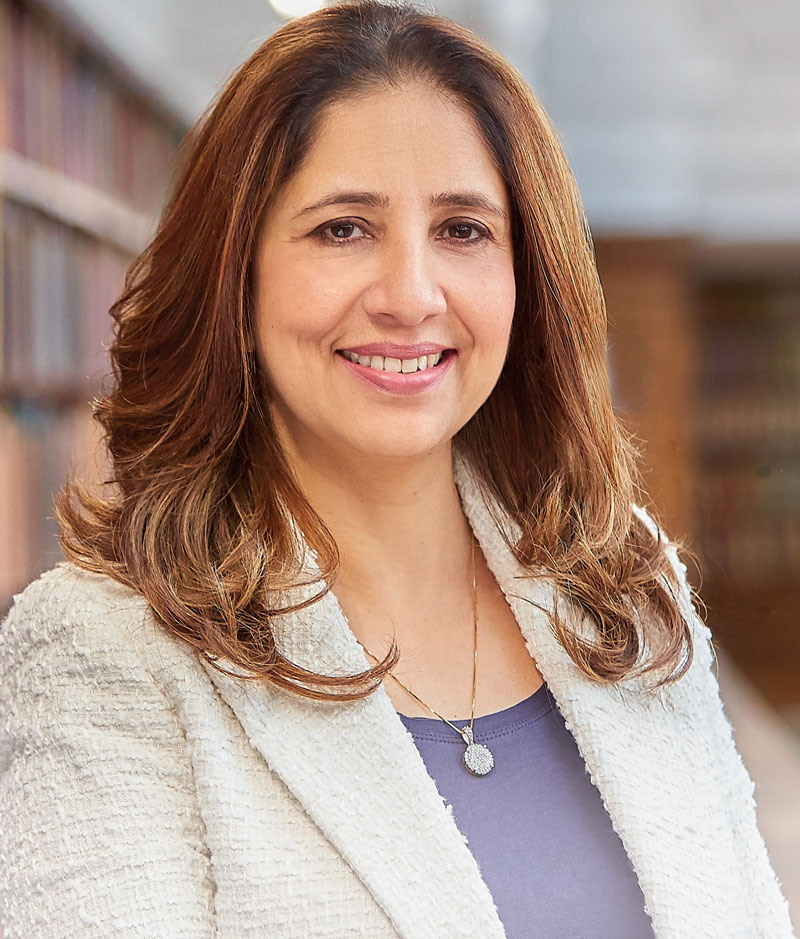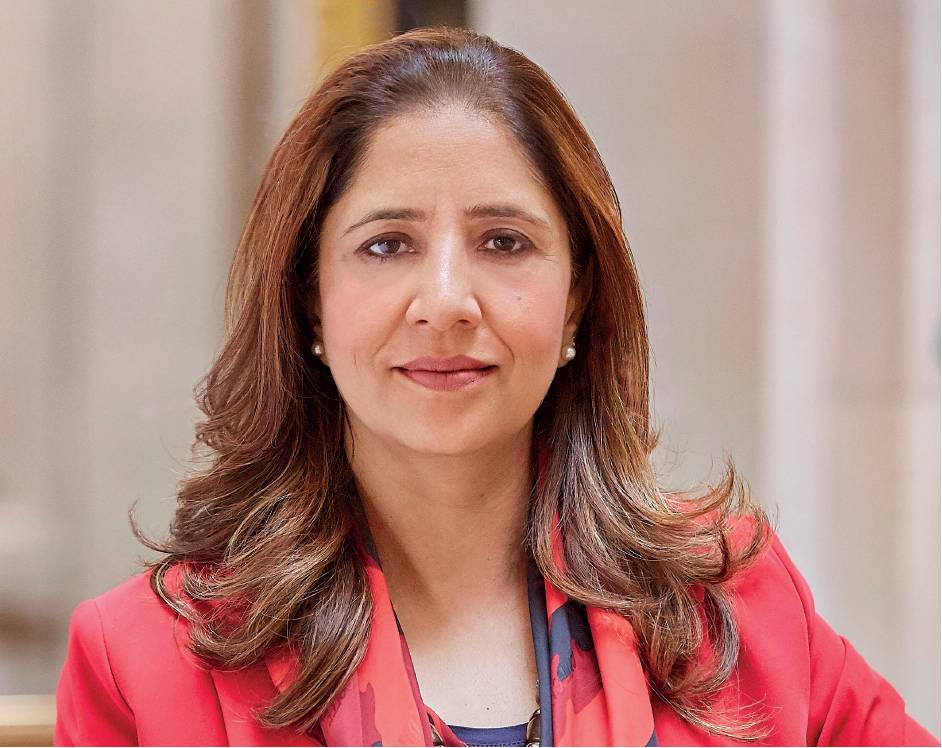Presidential Interview | Anusha Shah
Galvanising force
New ICE President Anusha Shah wants to put the environment and communities at the heart of infrastructure
By Belinda Smart
By Belinda Smart
As a girl, the ICE’s new President Anusha Shah had dreams of becoming a professional gymnast. But while her gymnastics days are behind her, she maintains remarkable agility in dealing with several challenges at once.
 “People always ask me, ‘How do you manage to juggle so many roles?’,” she says.
“People always ask me, ‘How do you manage to juggle so many roles?’,” she says.
“My response is always that I don’t see these things as different jobs; they all feed into the same motivation.”
If you’re wondering what those other roles are, Shah is, among numerous other things, senior director for resilient cities and UK climate adaptation lead at Arcadis, a Met Office non-executive director and a London Climate Change Partnership partner.
She also holds an honorary doctorate of engineering from the University of East London for services to addressing climate change and an honorary professorship at the University of Wolverhampton.
She is now adding to these with the 2023-24 ICE presidency, a position she officially took up on 7 November.
Of her appointment she says: “I’m hugely honoured, but with that honour comes a huge responsibility”.
As a water and environmental specialist, Shah is aware that this responsibility is underscored by growing urgency. Earlier this year, the Intergovernmental Panel on Climate Change, a key United Nations advisory body, forecast that the world can only emit another 500bn.t of carbon if it is to have a 50% chance of keeping global warming under the threshold set by the Paris Agreement, of a 1.5°C average global temperature increase since the 1800s. A new study published by Nature Climate Change on 30 October revealed that the current annual level of global carbon emissions is around 40bn.t, meaning that the 1.5°C target could be exceeded by the mid-2030s.
Far from being dispirited, Shah believes civil engineers possess untapped potential to solve many of the challenges posed by climate change. She plans to galvanise civil engineers and stakeholders from a range of sectors and communities to develop “the how” of delivering outcomes that mitigate and adapt to climate-related impacts and work to prevent biodiversity loss and social inequity.
“As an institution, as an industry, we all get the carbon agenda now, but I’m interested in what we do now to effect change,” she says. “For me, the presidency of the ICE is about getting the industry to be at the forefront of tackling challenges. The ICE has been the premier institute for 200 years, so it’s about how we make it relevant for the next 200 years”.
“We can’t do climate adaptation in isolation from mitigationTo do this, Shah’s remit will be about “opening the ICE’s doors” to a diverse range of ideas and insights. But chiefly, she believes that systemic change and a new mindset in civil engineering will be critical in achieving that goal.
Shah wants civil engineers to switch to a more holistic and end-user focused approach, which she believes will be critical to deal with the impacts of climate change.
“We can’t do climate adaptation in isolation from mitigation. We can’t do it in isolation from biodiversity net gain and we can’t do all three without social equity, because when droughts or floods occur it is the vulnerable who are most severely impacted.
“The challenge is, how do you bring these together and come up with integrated solutions that improve the lives of people and communities?”
For Shah, one way to do this is through nature-based solutions – initiatives that protect, sustainably manage and restore natural or semi-urban ecosystems to address societal challenges while benefiting communities and nature.
Her interest in nature-based solutions was ignited early on. Born and brought up in Kashmir, northern India, she grew up “surrounded by natural beauty” and after putting aside her early sporting ambitions, she wanted to work with water and nature. This culminated in working on environmental projects as a civil engineer.
Having initially been drawn to the “glamour” of architecture, she acknowledges that less-than-perfect grades for drawing had led her to switch to civil engineering, which ultimately proved the right choice.
“I have no regrets about not pursuing architecture, because my view of civil engineering over the years has changed so much. It’s become so much broader than perceptions at that time. We have such a huge opportunity to do so much, to literally improve quality of life for people and for communities, especially around the environment.”
“It was quite shocking but, as a civil engineer, it was very exciting and very challengingAfter completing her degree in civil engineering at the Jamia Millia Islamia University in India in 1997, Shah’s first job was as a project engineer for Development Alternatives, a New Delhi-based social enterprise and think tank involved with sustainable development. There she was engaged on a project to oversee the production of compressed earth building blocks. Her interest in sustainable projects had been sparked.
Before long she found herself working for IramConsult – the local partner for Dutch consultant Royal HaskoningDHV – on a lake conservation project in Kashmir. This entailed rehabilitating a lake polluted by sediment from the catchment and inflow of sewage.
“It was a massive, challenging project,” she recalls. “As an engineer I worked on a lot of detailed project reports, I learned CAD. I helped design the activated sludge process, entailing the aeration of sewage to support aerobic microorganisms that help break the sewage down. I realised that I really loved working on different aspects of the water cycle.”
This growing interest in water and the environment led her to enrol in the University of Surrey’s water and environmental engineering postgraduate course, funded through a Commonwealth scholarship, which she completed in 2000.
She went on to work on water projects in Kashmir and the UK, including as a design engineer on the construction site of the United Utilities’ Haweswater scheme in the Lake District.
This entailed building two pumping stations and laying 40km of pipeline. At the time Shah was employed by Black & Veatch but was seconded to contractor Clancy Docwra.
“That was another critical learning experience for me,” she recalls.
“Initially it was tough but it’s what gave me my chartership because I learned so much. I realised that although I was a designer, I had to work well with contractors, with ecologists and with local communities.
“It gave me a breadth of connections and an understanding of how those connections could work.”
Connections continue to be central to Shah’s way of working and she has always been motivated to link with people and organisations from all sectors and communities. She recently invited advertising agency Ogilvy’s vice chairman Rory Sutherland to her office to learn what advertising can teach engineers about designing solutions with “consumers” or end users in mind.
Another recent event was a forum to decode the barriers to nature positive outcomes in infrastructure, which encompassed perspectives from a range of sectors.
“It wasn’t just ICE civil engineers sitting in an echo chamber. We got people from non-governmental organisations, the Wildlife Trust and the finance sector who may not have worked closely with civil engineers before. It was so insightful to hear from them.”
“We as engineers tend to only bring in communities or other stakeholders when we’ve already thought of solutionsShe is also committed to using the ICE’s global reach to bringing international perspectives to the Institution’s initiatives and events.
“If we don’t involve the global population, how will we learn from other countries? In the global south there are so many resourceful and enterprising individuals and organisations, but they lack structure, operations and project management.
“The ICE is a global institution, so I really want to break down those boundaries.”
Aside from collaboration and cross-pollination, Shah re-emphasises the fact that user-centred engineering, which requires earlier engagement in projects, is the key to real progress. It is here that engineers’ mindsets really need to change, she says.
“We now see sectors within civil engineering talking to each other, but I would like to see that expanded.
“Engineers may have the best technical solution to a societal or infrastructure challenge, but if we are unable to convince politicians, if we are unable to convince communities and if we’re unable to bring in that true social equity and getting those people to own the project, I’m not sure we can consider that a true success.”
“Community engagement is important, but I also feel we as engineers tend to only bring in communities or other stakeholders when we’ve already thought of solutions.
“We need to engage with communities much earlier. We don’t bring them in at the stage of identifying their needs.”
She acknowledges that tackling climate impacts is no easy task, particularly with the clock running down, but luckily, she has a knack for collaboration.
“As ICE President, I’m the figurehead of course and I’ll be its voice for this one year, but I’m cognisant of the fact that I can’t do it alone. We need to open the doors of the ICE and work together across sectors, geographies and generations, because time is running out.”
As for the task of getting civil engineers to pivot towards early engagement and a tighter focus on end-users’ needs, Shah acknowledges the size of the challenge, but she is convinced it is achievable and vital.
“When faced with challenges, people tend to say, ‘That’s just how the system is’. But we are the system. We made the system, and we can make a new one. If the old one doesn’t fit, we need to change it.”

2019-Now
Senior director, resilient cities and UK climate adaptation lead, Arcadis
2020-2023
ICE senior vice president
2021- Now
Non-executive director, Met Office
2018-Now
London Climate Change Partnership Partner
2019-2022
Visiting professor, Royal Academy of Engineering
2018-2021
Leeds Beckett University external examiner, School of Built Environment & Engineering
2016-2020
Chair, Thames Estuary Partnership board
2018-2019
CEO Plan for Earth 2018 l Director, Jacobs
2016-2018
Head of stakeholder engagement, Team 2100
2015-2016
ICE Executive Board member
2010-2016
ICE Council Member and Trustee
2010-2016
Technical director, sustainable solutions and utilities, Jacobs
2008-2010
Principal engineer, Jacobs
2002-2008
Senior engineer, Black & Veatch
2001-2002
Assistant environmental engineer, J&K Lakes & Waterways, India
1998-1999
Assistant environmental consultant, Iram Consult, India
1997-1998
Project engineer, Development Alternatives - New Delhi Area, India